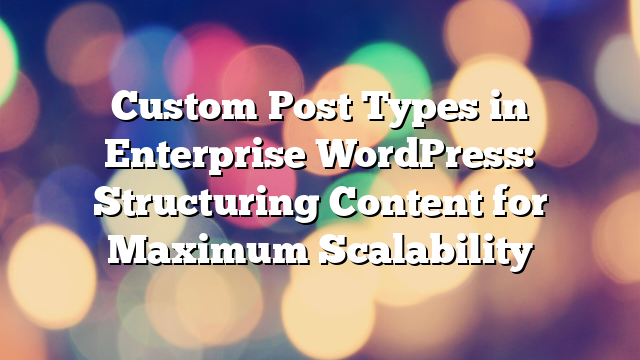Custom Post Types in Enterprise WordPress: Structuring Content for Maximum Scalability
27.04.2025

As enterprise businesses evolve, so do their content management needs. Out-of-the-box WordPress functionality may work for smaller projects, but enterprises often require more robust and structured solutions. Enter Custom Post Types (CPTs) — a powerful feature that allows businesses to organize and scale content in a way that aligns with their workflows, audiences, and objectives.
What Are Custom Post Types in WordPress?
In WordPress, everything from blog posts to pages is a “post type.” Custom Post Types let you define and create new content structures beyond the default options. Examples include portfolios, products, case studies, team members, and events — all tailored to your organization’s specific content needs.
Why Custom Post Types Matter for Enterprise Solutions
Enterprises often manage large volumes of diverse content, from press releases and documentation to case studies and internal knowledge bases. Using CPTs enables:
- Content Segmentation: Keep different types of content organized and easily accessible.
- Scalability: Add, update, and manage structured data across thousands of entries without bloating the core system.
- Improved UX: Present custom content types with distinct templates and navigation that match user intent.
Implementing Custom Post Types the Right Way
1. Define Your Content Architecture
Start by auditing your content and defining what types need to be separated. For example, if your enterprise runs an online university, you might create CPTs for Courses, Instructors, Webinars, and Certifications.
2. Register CPTs with Precision
Developers can use register_post_type() in the functions.php file or a custom plugin. Each CPT should be clearly named, hierarchical if needed, and support only the relevant features (e.g., comments, featured images).
3. Customize Admin UI for Editorial Teams
Enterprise WordPress solutions must be editor-friendly. Use the admin_menu and admin_init hooks to customize labels, filters, and user roles. This ensures editorial teams manage content efficiently without developer support.
4. Integrate CPTs with Taxonomies and APIs
Pair CPTs with custom taxonomies for advanced categorization. Expose them to the REST API for integration with front-end apps or third-party systems like CRMs, ERPs, or analytics platforms.
Case Study: Structuring a Corporate Knowledge Base
A Fortune 500 client of Vipe Studio needed a scalable internal documentation hub. Using CPTs for Guides, Tutorials, FAQs, and API Docs, we structured their knowledge base to support over 50,000 entries with real-time updates via REST API. The result? Reduced support tickets and increased internal productivity.
Conclusion
Custom Post Types are essential for any enterprise looking to elevate WordPress from a basic CMS to a powerful, scalable content management platform. Whether you’re managing 100 or 100,000 pieces of content, CPTs offer the flexibility and structure required to keep everything running smoothly.
If your business is ready to unlock the full power of Custom Post Types and elevate your WordPress site to enterprise standards, contact Vipe Studio today for a custom solution.



